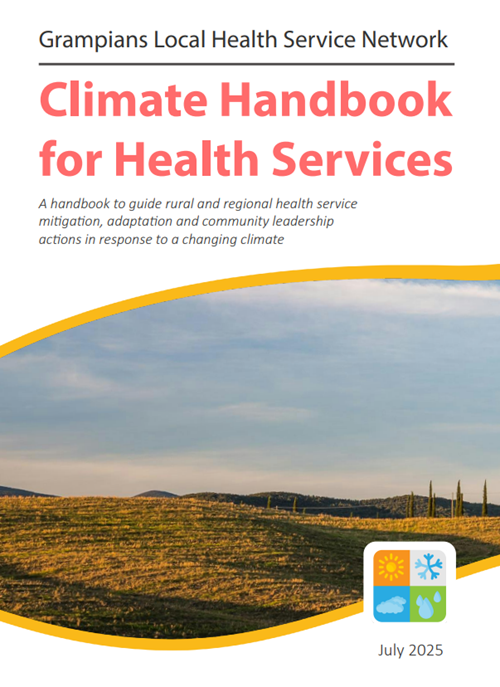Tackling Climate Change and Health
According to the World Health Organisation, climate change “affects the physical environment as well as all aspects of both natural and human systems – including social and economic conditions and the functioning of health systems”.
First reporting in 2015, an international expert panel of health scientists and clinicians has called climate change the greatest threat to health and well-being of the 21st Century.
For these reasons Tackling climate change and its impacts on health is one of the 10 key priorities of the Victorian Public Health and Well-being Plan 2023-2027.
In response, the Grampians Region Population Health Plan 2023-2029 included climate change and health as one of its priority areas for action. This webpage describes work undertaken as part of that priority area of action
For more information regarding the Grampians Public Health Unit’s (GPHU) Climate Change and Health portfolio please contact Professor Rosemary Aldrich.
Contact details
Sign up to the GPHU Mailing List
Convened by the GPHU and developed by and for staff of the eight public health services which comprise the Grampians Local Health Service Network (GLHSN), the Climate Handbook for Health Services sets out, in short handbook form, how smaller scale health services can respond to our changing climate.
The Handbook synthesises succinctly the case for why climate action is needed, evidence for ideas and feasible actions considered most relevant to regional, rural and smaller scale health services, and tools and tips for teams to assist in taking action.
Specifically the Handbook sets out briefly the why, the what, and the how of
- climate risk assessment to determine a health service’s priorities for climate action
- mitigation actions to reduce health care-related emissions
- adaptation actions to manage risk and adjust to the changing climate, and
- how health services, as the anchor institutions they are, might work with their local communities to build community adaptive capacity to both strengthen resilience to climate risks and take opportunities which might arise as they do so.
Additionally the Handbook includes strategies and methods for measuring progress, impacts and outcomes of actions taken so that a health service can track its effectiveness over time.
The Heatwave HELP (Health Emergency Local People) project aims to reduce heat-related morbidity and mortality through locally-led resilience-building in three local government areas (LGAs).
Guided by local project control groups in Horsham Rural City, Northern Grampians Shire, and Hepburn Shire, GPHU Heatwave HELP coordinators and a public health physician are training community leaders across faith, care, cultural, business, services, sport, volunteer, social, health and other networks to identify people they know who might be at high risk of heat harm, and to then support those people to stay safe from heat on hot days and periods of severe heat.
Project activities across the LGAs include:
- Developing locally-appropriate heat health strategies suited to local context, capacity, and needs, and which build on the expertise of key local partners including councils, Aboriginal Cooperatives (Budja Budja and Goolum Goolum), and health organisations
- Spreading clear, simple messages (HEAT, SAFE) about heat risks and low-tech ways to stay safe through community workshops, information sessions, partnering with local media (including ABC), and across the networks of those community leaders trained in understanding who is at risk from heat and ways to stay safe
Outcomes to date include high levels of confidence to act among the hundreds of community leaders so far trained in understanding heat risks and supporting others to stay safe, strong multi-agency and cross-sectoral collaboration, and increasing heat risk awareness across our communities in general.
The Heatwave HELP project is funded 2024-2026 by the Australian Government and Victorian Government under the National Partnership Agreement on Disaster Risk Reduction. Our project seeks to find a reduction in adverse health impacts due to heat, using data collected via local emergency department visits, hospital admissions, Ambulance Victoria callout data, and from other sources.
HeatwaveHELP grant partners and Steering Committee members 2024-2026.
- ABC (Australian Broadcasting Corporation) Victoria
- Ambulance Victoria
- Budja Budja Aboriginal Co-operative
- Central Highlands Rural Health
- Consumer representation
- Department of Health, Victoria
- Department of Families Fairness and Housing, Victoria
- East Wimmera Health Services
- Goolum Goolum Aboriginal Co-operative
- Grampians Health
- Grampians Public Health Unit (Chair)
- Griffith University
- Hepburn Shire Council
- Horsham Rural City Council
- Northern Grampians Shire Council
- Western Victoria Primary Health Network
Training in the HEAT SAFE approach used in the Heatwave HELP project can be accessed here; or watch this training video for health providers here.
HEAT SAFE resources that you can download and print for display are available below:
Grampians Health has been part of and contributed to the work of the Australian Transitions to Sustainable Health Systems Consortium. Convened by the Monash Sustainable Development Institute, in 2024 and 2025 the Consortium together developed the comprehensive resource.
The guide sets out how, by targeting nine priority areas, to build a health system which works to decarbonise while delivering the services that Australians expect of their health services.
The Guide is available:
- As a summary or
- As the full guide (which includes case studies and useful resources)
Grampians Health’s case study on its Health Resource Stewardship program is reported on page 76.


